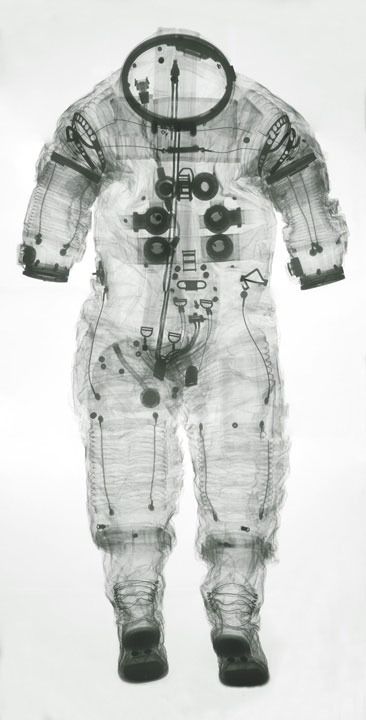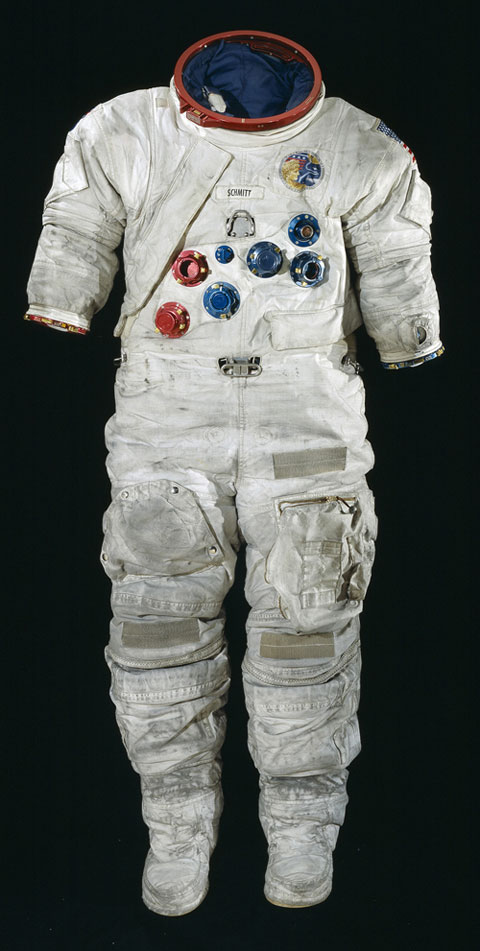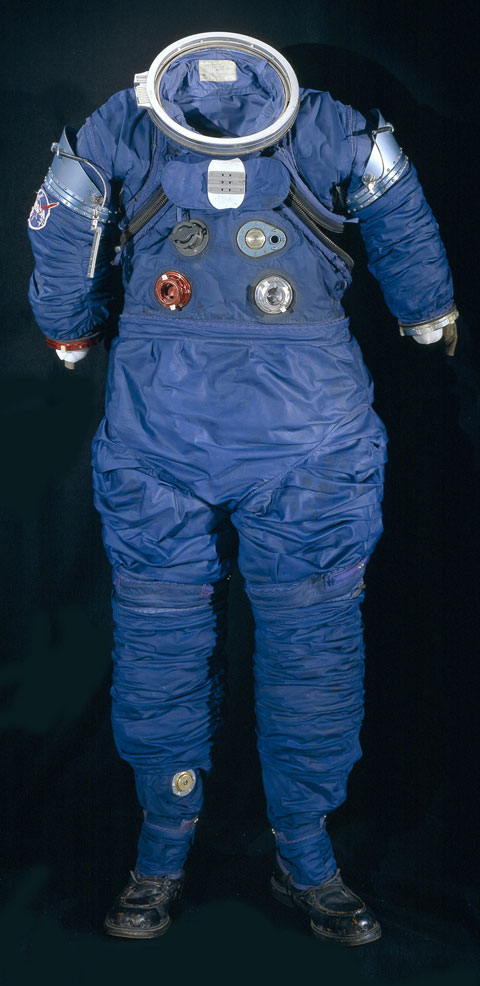|
|

|
|
Author
|
Topic: Spacesuits (Amanda Young)
|
cspg
Member Posts: 6210
From: Geneva, Switzerland
Registered: May 2006
|
 posted 12-01-2008 10:00 AM
posted 12-01-2008 10:00 AM
   
Spacesuits : :
Within the Collections of the Smithsonian National Air and Space Museumby Amanda Young with photographs by Mark Avino
Introduction by Alan Needell
Foreword by Thomas P. Stafford The goal of landing a man on the Moon and returning him safely to Earth required the development of three things: spacecraft, launch vehicles, and protective clothing. Spacesuits: Within the Collections of the Smithsonian National Air and Space Museum takes the reader through the development of the last category, the spacesuits used during this venture. Highlighting the pressure suits created during the years leading up to the lunar missions and beyond, this book features dramatic photographs of the Smithsonian's collection, as well as never-before-published historical images of spacesuit development and testing -- range-of-motion studies, for example, in which researchers wore spacesuits while playing baseball and football. The book also includes a group of advanced spacesuits, which, though never used on a mission, are in many respects the most exciting suits ever created. One suit glove has steel fingernails and sharkskin pads, in an attempt to harness the abilities of the human hand.Spacesuits are surprisingly fragile; they are made for a short lifespan in the most extreme of conditions, and long-term survival is not part of their design process. The final chapter touches briefly on the current conditions of historic suits, how they have held up over time, the reasons for their deterioration, and the rewards and difficulties associated with caring for and preserving these very complex and iconic artifacts. From the first spacesuit designs of the 1930s through those worn on the landmark Apollo-Soyuz program of 1975, Spacesuits provides a behind-the-scenes look at the history of these remarkable creations, including some that have never before been publicly displayed. Amanda Young is a museum specialist in Spacesuits and Astronaut Equipment for the Division of Space History of the Smithsonian National Air and Space Museum. She was responsible for the Air and Space portion of "American Festival Japan '94", a major exhibit in Tokyo, and in 2001 co-wrote the collections care booklet "The Preservation, Storage and Display of Spacesuits." She was also a contributor to Extreme Textiles: Designing for High Performance (Princeton Architectural Press, 2005) and After Sputnik: 50 Years of the Space Age (Collins, 2007). She continues to conduct research into the causes of spacesuit deterioration. Mark Avino is the Chief of Photographic Services in the Office of Communications for the National Air and Space Museum. In addition to a wide variety of photography undertaken at the Museum, he has also contributed to numerous publications and books on the museum's collections, including In the Cockpit: Inside 50 History-Making Aircraft (Collins Design, 2007) and At the Controls: The Smithsonian National Air and Space Museum Book of Cockpits (Boston Mills Press, 2001). A graduate of the Rochester Institute of Technology, he joined the Smithsonian Institution in 1983. He lives with his wife and three children in Burke, Virginia. Allan A. Needell is the Curator of Human Space Flight in the Division of Space History at the National Air and Space Museum. He has published on the history of physics, the origins of American national laboratories, and government/science relations. He is the author of a study of the career of a major American science administrator, Science, Cold War and the American State: Lloyd V. Berkner and the Balance of Professional Ideals (Routledge, 2000). Needell joined the National Air and Space Museum in 1981 and is currently responsible for the museum's Apollo space flight collection. Thomas P. Stafford is a retired Lieutenant General of the U.S. Air Force and a former NASA astronaut. Stafford piloted Gemini VI, the first rendezvous in space (1965), and commanded the Apollo 10 lunar mission (1969) and the historic Apollo-Soyuz Test Project (1975). He is the recipient of many awards in aviation and honorary degrees from American universities. - Hardcover: 128 pages
- Publisher: Power House Books (June 2009)
- ISBN-10: 1576874982
- ISBN-13: 978-1576874981
|
Rick Mulheirn
Member Posts: 4167
From: England
Registered: Feb 2001
|
 posted 12-01-2008 02:37 PM
posted 12-01-2008 02:37 PM
   
This is one publication I know has been in the pipeline for six or more years and one I have been eagerly awaiting.Finally... Amanda Young and her team will get the credit and plaudits they deserve for their tireless, unsung and unseen efforts in restoring and preserving the national spacesuit archive. I have visited the Garber Storage Facility in Washington which houses the collection. In common I suspect with many on this site, it had never occurred to me the suits might degrade or deteriorate in any way; sheesh, they have to deal with arguably the most hostile environment known to man. Yet I was shocked to discover first hand just how fragile these iconic artifacts are. Without the work of Amanda Young and her colleagues many of the suits we all take for granted whilst tramping around the NASM, JSC, etc. would have deteriorated to the point where they would have been packed away in boxes never to be seen again by the general public. It is my understanding this will be a "coffee table" style book packed with stunning and lavish photographs of the collection and one not to be missed. |
Robert Pearlman
Editor Posts: 42981
From: Houston, TX
Registered: Nov 1999
|
 posted 02-07-2009 10:45 AM
posted 02-07-2009 10:45 AM
   
Here are three sample photographs -- including an x-ray -- taken for Spacesuits. 

|
kr4mula
Member Posts: 642
From: Cinci, OH
Registered: Mar 2006
|
 posted 05-05-2009 11:25 AM
posted 05-05-2009 11:25 AM
   
According to Amazon, this book is available earlier than originally announced and my copy shipped yesterday. I'm very much looking forward to it. |
collocation
Member Posts: 383
From: McLean, VA, USA
Registered: Feb 2004
|
 posted 05-07-2009 11:21 PM
posted 05-07-2009 11:21 PM
   
Smithsonian Magazine: After Space, Saving Suits, Boots and Gloves "Jack is the most beautiful. I just adore Jack," says Amanda Young, 62, eyeing a wall of photographs. She is perched on a short stepladder in her workshop at the National Air and Space Museum's Paul E. Garber Facility in Suitland, Maryland. "Gene is gorgeous," she adds. "Mike has knee problems." Amanda Young, who is featured in the article, is author of the book that is the subject of this thread. |
kr4mula
Member Posts: 642
From: Cinci, OH
Registered: Mar 2006
|
 posted 05-08-2009 11:24 AM
posted 05-08-2009 11:24 AM
   
I haven't read the whole book yet, but this looks like a fantastic resource, as well as a very pretty book. The size of the book is sort of weird, at 12" tall and about 6" wide. The photos inside of the museum's collection, especially the x-rays, are phenomenal. There's a lot more text than I expected. It's a good primer on suits, but doesn't seem to say much new to those familiar with the topic. The last few pages are perhaps the most valuable: a catalog of all the NASM's suits, with dates, serial numbers, manufacturers, notes, etc. Those of us in the relatively small community interested in suit history know that one of the hardest tasks has been definitely identifying serial numbers to pair with existing hardware and past documentation. Here, we've got the best efforts thus far. Overall, a great book to look at and keep handy as a reference, but not a narrative history of the topic (nor does it purport to be). Many kudos to Amanda for putting together the book and for all her preservation efforts. |
collocation
Member Posts: 383
From: McLean, VA, USA
Registered: Feb 2004
|
 posted 06-14-2009 11:06 AM
posted 06-14-2009 11:06 AM
   
Washington Post:
High Fashion: A Spacesuit Expert Celebrates Out-of-This-World Ensembles Spacesuits are the ultimate in couture. Think about it: custom-fit garments, dozens of layers deep, made from innovative textiles that can run $5,000 per square foot, with eye-catching accessories. And the footwear? Near impossible to walk in.Often, the outfits are worn just once before becoming fragile artifacts that deteriorate and corrode. "To last was never a consideration," says Amanda Young, spacesuit caretaker for the National Air and Space Museum. "They were built to do their short, hard job with no failures." Gemini suits, moon-dust-coated boots and Neil Armstrong's gold-visored helmet -- all preserved in the Smithsonian's Paul E. Garber Facility in Suitland under Young's careful watch -- are just some of the stars of her new book, "Spacesuits: The Smithsonian National Air and Space Museum Collection." The book focuses on the evolution from the pressure suits of the 1930s, used by aircraft pilots trying to reach higher altitudes, to the R2-D2-like fiberglass and woven steel suits of the post-Apollo period. |
MrSpace86
Member Posts: 1618
From: Gardner, KS, USA
Registered: Feb 2003
|
 posted 07-07-2009 11:50 PM
posted 07-07-2009 11:50 PM
   
I briefly flipped though this book while I was at the NASM and it looked awesome. I believe this was addressed before, and the answer may even be in the book, but why is Neil Armstrong's suit not on display? I mean, if his is so fragile, wouldn't Aldrin's suit also be just as fragile? Personally, I am all about preserving these artifacts for generations to come. But if they are not on display, what's the point of preserving them in the first place? No one is really being inspired by seeing a sign that says 'removed for conservation' or whatever the sign said. |
Robert Pearlman
Editor Posts: 42981
From: Houston, TX
Registered: Nov 1999
|
 posted 07-08-2009 12:03 AM
posted 07-08-2009 12:03 AM
   
My understanding is that Aldrin's and Armstrong's suits will be rotated from this point forward, to give one a chance to "rest" while the other is displayed in the museum. quote:
Originally posted by MrSpace86:
But if they are not on display, what's the point of preserving them in the first place?
Just as important as their public display, artifacts such as the spacecraft and spacesuits and being preserved so that future researchers -- whether they are engineers, scientists or historians -- have the opportunity to study them. In fact, it need not even be future researchers. NASA and its contractor teams are currently using the Apollo spacecraft and spacesuits to learn how to best design the next generation of exploration vehicles and equipment. The lessons learned from these artifacts are more than worth the effort put into their preservation. |
MrSpace86
Member Posts: 1618
From: Gardner, KS, USA
Registered: Feb 2003
|
 posted 07-08-2009 02:04 AM
posted 07-08-2009 02:04 AM
   
I wondered more about the spacesuits after I had toured the museum and picked up the book at the gift shop. It is truly impressive if you are into spacesuits and such. It would be nice if a book about Russian spacesuits were made. I hope there are plans for it in the works! |
Robert Pearlman
Editor Posts: 42981
From: Houston, TX
Registered: Nov 1999
|
 posted 07-08-2009 05:20 AM
posted 07-08-2009 05:20 AM
   
There is a book about Russian Spacesuits , though it not the visual treat that Amanda Young's "Spacesuits" is... , though it not the visual treat that Amanda Young's "Spacesuits" is... |
Matt T
Member Posts: 1368
From: Chester, Cheshire, UK
Registered: May 2001
|
 posted 07-08-2009 02:56 PM
posted 07-08-2009 02:56 PM
   
Finally picked this up and I'd echo everyone's comments, it's a great addition to spacesuit history, particularly in conjunction with the 'US Spacesuits' (Thomas and McMann) book. The chance to see such detailed images of some of the suits is very welcome, and (presumably partly as a consequence of the work undertaken for this book) much more of the collection can now be viewed online at the National Air and Space Museum (NASM) site, though at a much lower quality. Reading the catalogue I was rather surprised to discover that the prototype SPD-117 Apollo suit I have is not represented in the national collection, which otherwise seems to contain at least one example of pretty much every Apollo variant. Given that it's the very first suit model that ILC took to NASA and marks the genesis of the Apollo suit program I'm torn between being incredibly pleased and rather concerned. I'm off to double-check the blackout blind and the thermometer and humidity meters again.  |
NASAgoob
Member Posts: 96
From: Dallas, Texas, USA
Registered: Oct 2008
|
 posted 07-08-2013 09:33 PM
posted 07-08-2013 09:33 PM
   
I just recently discovered Amanda's great book about Spacesuits, and had seen her in a couple of documentaries in the past year. In researching for a National Air and Space Museum address on the outside chance of getting my book autographed I read Amanda retired in 2009. Anyone know if the museum could get a letter to her? It's a long shot but doesn't hurt to ask. Thanks. Editor's note: Threads merged. |
denali414
Member Posts: 593
From: Raleigh, NC
Registered: Aug 2017
|
 posted 04-05-2018 03:09 PM
posted 04-05-2018 03:09 PM
   
Just picked up this book — what awesome pictures and such a great guide and reference for the Smithsonian collection of spacesuits. Highly recommend. |
p51
Member Posts: 1642
From: Olympia, WA
Registered: Sep 2011
|
 posted 04-05-2018 05:26 PM
posted 04-05-2018 05:26 PM
   
quote:
Originally posted by MrSpace86:
I wondered more about the spacesuits after I had toured the museum and picked up the book at the gift shop. It is truly impressive if you are into spacesuits and such.
Yeah, I got my copy soon after you got yours, it seems, and in the same place. I always hit gift shops at museums and when I saw this I wasn't quite the space fan that I am now (in terms of knowing as much as I do now, anyway) and I thought, "Man, I GOTTA have this!"I've looked through it several times since then. Yeah, the size of the book is very odd but the info contained therein is well worth the cover price! |
denali414
Member Posts: 593
From: Raleigh, NC
Registered: Aug 2017
|
 posted 04-07-2018 09:46 AM
posted 04-07-2018 09:46 AM
   
I could be wrong, but I think the size of the book more being a "field guide" than a "coffee book." The smaller size is much easier to bring to an auction or other museums to compare items or see what they have done. | |
Contact Us | The Source for Space History & Artifacts
Copyright 2020 collectSPACE.com All rights reserved.

Ultimate Bulletin Board 5.47a
|
|

|
 advertisement advertisement

|















